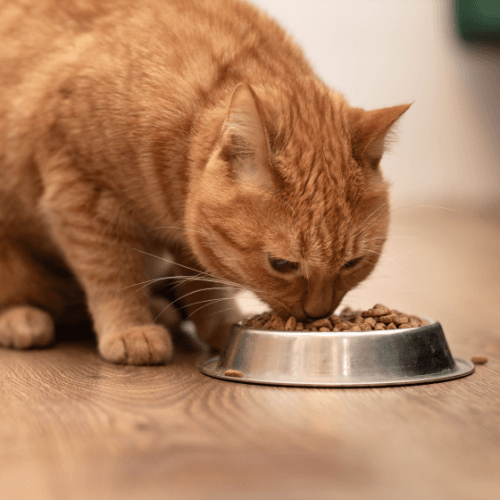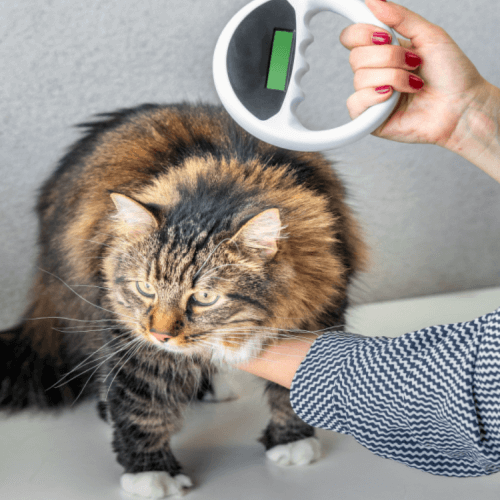Home / Compare Pet Insurance / How to look after a cat




Key takeaways
- It’s important for new cat owners to research a cat’s needs before purchasing or adopting a cat, especially as premiums for pet insurance can vary based on different breeds.
- To help your cat have positive experiences when it’s living with you, you’ll need to understand the basics of how to look after a cat.
- Look at getting pet insurance to cover your cat early for peace of mind, and so it’s less likely to have pre-existing conditions.
Basics on how to look after a cat
Whether you’re a first-time cat owner, getting a kitten or adopting a stray, basic cat care goes beyond feeding and giving your pet a place to sleep. Cats need a balanced diet, regular veterinary care, mental stimulation and playtime to stay happy and healthy. Providing things like scratching posts, cosy spots to rest, clean food and water bowls, and a clean litter box is also important. Meeting your cat’s needs can help you maintain their wellbeing and help your furry family member live a long and comfortable life.
Feeding your cat
 Cats are obligate carnivores, which means their diets must include meat.1 They can have small amounts of vegetables but can’t survive on a vegetarian diet.
Cats are obligate carnivores, which means their diets must include meat.1 They can have small amounts of vegetables but can’t survive on a vegetarian diet.
Cat food can be either wet (e.g. meat, canned food) or dry (e.g. kibble), and both have good health benefits. The RSPCA recommends a balanced diet of wet food and dry food for your cat, with fresh water always available for them to drink.1
As well as commercial cat food, you can feed your cat fresh, raw, human-grade (i.e. for humans) meat like chicken and lamb. The RSPCA recommends avoiding pet food that contains raw meat as it might have preservatives that aren’t good for your cat’s health.
Cats also enjoy meaty bones as they help to keep their teeth sharp, but these need to be raw, as cooked bones splinter easily and can cause catastrophic and sometimes fatal damage to your cat’s insides. Cats can also have fish (including canned fish) as an occasional treat.1
As for what cats can’t eat, the list is rather long. According to the RSPCA, some of the foods that are toxic to cats include:
- Tomatoes
- Avocado
- Onions (including onion powder)
- Grapes, raisins, sultanas, and currants
- Chocolate
- Garlic
- Caffeine
- Mushrooms
- Nuts, fruit stones/pits and fruit seeds.
Perhaps surprisingly, you also shouldn’t give your cat milk because it causes gastrointestinal problems.1
Adult cats usually prefer to eat several smaller meals throughout the day, so you should offer your cat some food with clean water four to five times a day. Kittens should be given food at least four times daily but be careful not to overfeed them.2
Cat grooming
For the most part, cats will groom themselves, but you still have a role to play as their owner.
Regular grooming of their fur will help remove the loose hairs that would otherwise be swallowed by your cat and form a hairball. Hairballs aren’t usually a cause for concern, but some can grow large enough to block your cat’s intestines, especially for long-haired cats.3
Cat grooming will also help keep your cat’s coat healthy, enable you to check for fleas, and prevent tangling and matting. However, bathing your cat isn’t typically recommended, as most cats don’t enjoy it. Bathing can be useful for treating some skin conditions, but your vet will advise you on this.
Dental care
Taking care of your cat’s teeth can help to ensure their overall health is in good shape. Keeping your cat’s teeth in good condition can help to prevent plaque and tartar from building up and more serious conditions like periodontal disease.4
Luckily for you, cat dental care can easily be done at home. Brush your cat’s teeth daily (using special cat toothbrushes and paste) and ask your vet about your cat’s dental diet. You can also give your cat dental chews and toys that can help reduce the buildup of plaque and tartar.
An annual vet check-up can also help keep your cat in good health, both dental-wise and in general.
Keeping your cat inside
Most domestic cats are raised as indoor cats, so it’s possible to keep your cat safe and happy by keeping them inside the home rather than letting them roam around outside. 18
By keeping your cat at home and preventing them from roaming around your neighbourhood, you can reduce the risk of them getting into fights, catching an infection from another cat, being hit by a car, or being involved in another traumatic accident.5
This doesn’t necessarily mean your cat must always be indoors. You can provide your cat with an outdoor enclosure or install escape-proof fencing around the perimeter of your yard for added enrichment and play time. Alternatively, you can supervise your cat when it’s out in the garden.
If you don’t have an escape-proof backyard or live in an apartment block, you can take your cat for a walk. The RSPCA does not recommend this but advises if you do decide to walk your cat, you should use a lead and cat harness and ensure they’re up to date with their vaccinations.
Insurance for your cat
One more way to care for your cat is by taking out pet insurance.
It’s not nice to think about, but throughout your cat’s life, they may get into accidents or suffer from different health problems, especially if they’re older cats. When these things happen, the last thing on our minds is dealing with the vet bills, which can quickly climb.
This is where pet insurance can help you. Depending on the type of cover you have for your cat, you can claim a portion of your vet bills back and enjoy other inclusions, like annual limits for routine care.
Finding the right insurance for your cat can be tricky, so why not compare your options? Our pet insurance comparison service is a quick and easy way to weigh up policies side-by-side. To get started, all you need to do is input your pet’s details and your details. Simples!
How to look after a kitten
Looking after a new kitten requires attention to their basic needs, from feeding and socialising to providing a safe environment. Kittens are playful and curious, so the most important thing is creating a space for them to explore, learn and grow. Proper nutrition, regular vet visits, and lots of love and patience can help your kitten develop into a healthy, happy adult cat.2
Getting your cat microchipped and registered
 One of the most important ways to care for cats is getting them microchipped and registering them with your local council. Microchipping is a permanent method of electronic identification. It involves implanting a tiny microchip under your pet’s skin, which is linked to a database with yours and your pet’s details. Only vets or authorised implanters are allowed to microchip pets. Microchips ensure that lost pets can be reunited with their owners, so you must keep your contact details current.6
One of the most important ways to care for cats is getting them microchipped and registering them with your local council. Microchipping is a permanent method of electronic identification. It involves implanting a tiny microchip under your pet’s skin, which is linked to a database with yours and your pet’s details. Only vets or authorised implanters are allowed to microchip pets. Microchips ensure that lost pets can be reunited with their owners, so you must keep your contact details current.6
It’s important to remember that microchipping is mandatory for cats and dogs in Australia, with the states and territories mandating the age at which they should be microchipped. Check your state/territory’s laws around cat microchipping and ask your local council if you’re unsure. Here’s a summary of pet microchipping requirements around Australia:
- New South Wales (NSW): Cats and dogs must be microchipped by 12 weeks of age or before being sold or given away, whichever happens first.7
- Victoria (VIC): Microchipping is mandatory for cats and dogs before registration with a Victorian local council.8
- Queensland (QLD): Cats and dogs must be microchipped by the age of 12 weeks.9
- Western Australia (WA): Cats older than six months and dogs older than three months must be microchipped.10
- South Australia (SA): Microchipping is mandatory before dogs reach 12 weeks or within 28 days of acquiring the pet. Cats aren’t required to be registered in SA.11
- Tasmania (TAS): Dogs must be microchipped by six months of age and cats by four months of age.12
- Australian Capital Territory (ACT): Dogs must be microchipped by eight weeks of age or within 28 days of acquiring the pet. Cats aren’t required to be registered in the ACT.13
- Northern Territory (NT): Microchipping is not mandatory in the NT, except for the City of Darwin, where cats and dogs older than three months must be microchipped.14
Whether or not you’re required to register your cat with your local council will depend on which local government area you live in, as each council has different rules and fees for registering cats.
Since there are hundreds of local councils around Australia, we’ve only included the broad registration requirements for each state and territory. Be sure to check your local council’s registration rules, as your local council may require your cat to be microchipped before it can be registered.
Kitten food
Kittens have very specific nutritional needs that change as they grow, so it’s important to provide the right pet care at each stage of their development.2
Newborn kittens, for example, rely on a mother cat for milk or a kitten milk replacement, as the kittens’ health is too immature for solid food. As they reach around four weeks, you can start introducing wet kitten food that’s easy to digest, gradually transitioning them to solid food by the time they’re around eight weeks old.2
Young kittens between two and six months old require a high-quality diet that supports the kittens’ needs for rapid growth, with a higher protein and fat content than adult cat food. After six months, you can switch to a kitten-formulated food that supports continued development until they’re ready for adult cat food at around 12 months.2
Each growth stage is crucial and feeding your kitten the right food helps to ensure your pet grows up strong and healthy.
Litter box training
Litter box training is an essential part of caring for cats, especially if you have an indoor cat. To start, you’ll need to place your cat’s litter tray in an area that gives them privacy and isn’t near their food and water. This location should be permanent, as moving the tray around can confuse your kitty.15
As for training your kitten to use the tray, take them to the litter box after each meal and let them dig around in the litter. Praise them when using it, but don’t punish them if they accidentally go outside the tray. Change the litter often, as cats may refuse to use a dirty litter tray.
If you notice your cat isn’t using the litter tray, you can try changing the type of litter you use. If this doesn’t fix the problem, but you may need to consult a vet in case there’s an underlying medical reason why your cat has changed its toilet habits.
Desexing
De-sexing (also known as spaying or neutering) can have several health benefits for your cat and should ideally be done before they reach breeding age (around 16 weeks old).
Cats can be de-sexed once they reach one kilogram in weight or from eight weeks old. If you’ve adopted your cat from a shelter, they may already be de-sexed.
The most obvious benefit of de-sexing your cat is preventing unwanted litters, but it can also reduce your cat’s risk of getting mammary cancer and help to reduce the risk of uterine infections. De-sexing can also positively affect your cat’s behaviour, as de-sexed cats are less likely to roam outdoors (and, in turn, less likely to get injured in an accident or pick up an infection). De-sexed cats are also less aggressive than those not de-sexed, reducing the risk of your feline friend getting into a scuffle.19
Kitten vaccinations
Vaccinating your kitten is a preventive care method to protect them against specific infectious diseases caused by viruses and bacteria.
The core cat vaccine is a combination of vaccines for feline panleukopenia (enteritis), feline calicivirus and feline herpesvirus (both forms of ‘cat flu’). This vaccination combination is commonly known as the F3 vaccination 16
There are also non-core vaccines for diseases like feline immunodeficiency virus (FIV) and feline leukemia virus (FeLV). However, these vaccines are only recommended for cats with a higher risk of these illnesses (consult a vet for more information). You should also be following up with worming, flea and tick treatment for kittens.20
What is a healthy cat’s weight?
Every cat is different, and their average weight will hugely depend on their breed, age, sex and health condition. Generally, a healthy cat will weigh between three and six kilograms, depending on their breed.17
Numbers are not the only way to tell if your cat is overweight or underweight. You can also check by giving them a good once over and checking their physical conditions as follows:
Normal healthy cat
- You can easily feel their ribs, and the ribcage will be covered in a small layer of fat.
- Your cat’s belly should have a slight tuck, in a gentle and upward curve.
- Your cat should have a clearly defined waistline with no excess fat, arching up from their ribs to their hips.
- You should be able to feel your cat’s spine, covered in a small layer of fat, throughout their fur.
Overweight cat
- You cannot easily see or feel their ribs and ribcage.
- Your cat’s belly is hanging low, and it’s plump or chubby.
- You’re unable to see your cat’s waistline.
- If you’re unable to feel your cat’s spine easily and can only feel their fat, they are probably overweight.
Underweight cat
- You can easily see and feel their ribs, but you cannot find the small layer of fat covering them.
- Your cat’s belly is tucked in behind their ribs, and ribs may be visible from their front and side profiles.
- You’ll be able to see and feel their spine easily.
Meet our pet insurance expert, Adrian Taylor
As a General Insurance expert with over 13 years’ experience in financial services, Adrian Taylor knows that dogs and cats get themselves into all sorts of mischief. One part of Adrian’s work is to help empower consumers to understand how pet insurance can help save them from exorbitant vet bills when their pet gets injured or falls ill.
Want to know more about pet insurance?
1 RSPCA Knowledge Base – ‘What should I feed my cat?’ Accessed June 2025.
2 RSPCA Knowledge Base – ‘What should I feed my kitten?’ Accessed June 2025.
3 RSPCA Knowledge Base – ‘How often do I need to groom my cat?’ Accessed June 2025.
4 RSPCA Knowledge Base – ‘How should I take care of my cat or dog’s teeth?’ Accessed June 2025.
5 RSPCA Knowledge Base – ‘Is it ok to keep my cat at home all of the time?’ Accessed June 2025.
6 RSPCA Knowledge Base – ‘Is microchipping mandatory for cats and dogs?’ Accessed June 2025.
7 NSW Government (Office of Local Government) – ‘Microchipping and Registration.’ Accessed June 2025.
8 Agriculture Victoria – ‘Microchipping of dogs and cats.’ Accessed June 2025.
9 Queensland Government – ‘Laws for pet owners in Queensland.’ Accessed June 2025.
10 Western Australia Veterinary Practise Board – ‘Guidelines on the Microchipping of Dogs and Cats.’ Accessed June 2025.
11 Department for Environment and Water – ‘Understand SA’s new pet microchipping laws.’ Accessed June 2025.
12 Tasmanian Government (Department of Natural Resources and Environment Tasmania) – ‘Desexing and Microchipping.’ Accessed June 2025.
13 ACT Government (City Services) – ‘Pets and Wildlife.’ Accessed June 2025.
14 City of Darwin – ‘Pet Registration & Microchipping.’ Accessed June 2025.
15 RSPCA Knowledge Base – ‘How do I litter-train my cat?’ Accessed June 2025.
16 RSPCA Knowledge Base – ‘What vaccinations should my cat receive?’ Accessed June 2025.
17 Bluecross Organisation – Cat weight. Accessed June 2025.
18 Vet West. Indoors or outdoors? What is right for your cat. Accessed June 2025
19 Greencross Vets. Desexing cats and kittens. Accessed June 2025.
20 Greencros Vets. Kitten vaccinations. Accessed June 2025.

